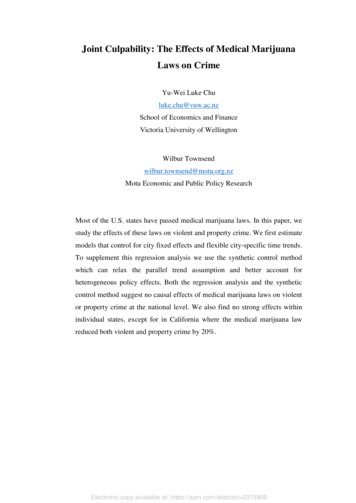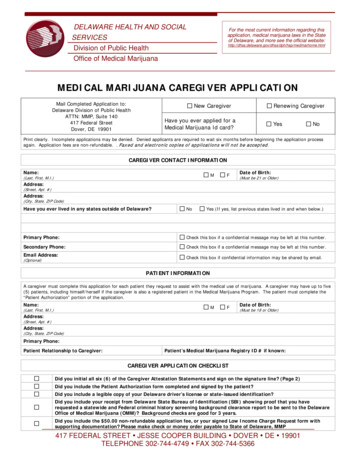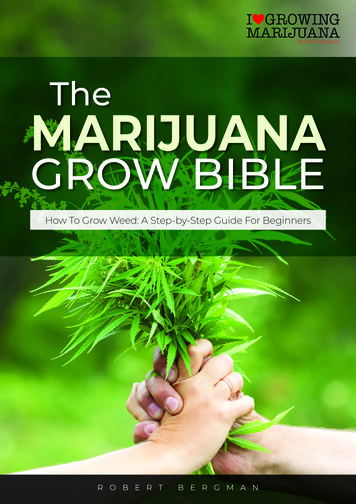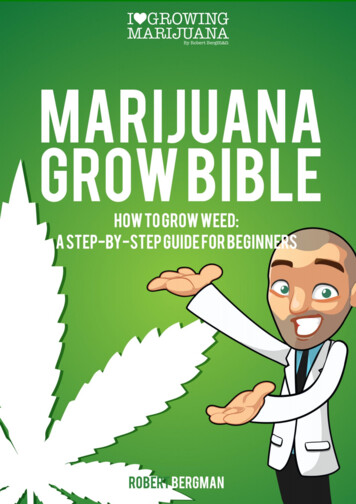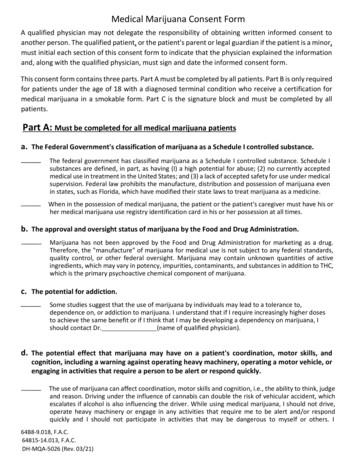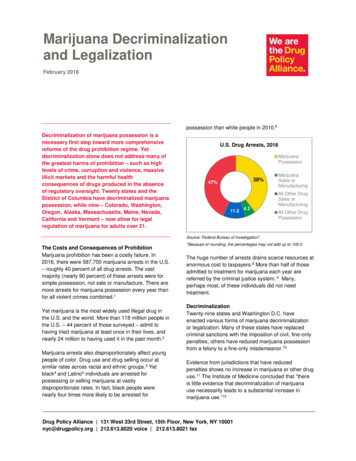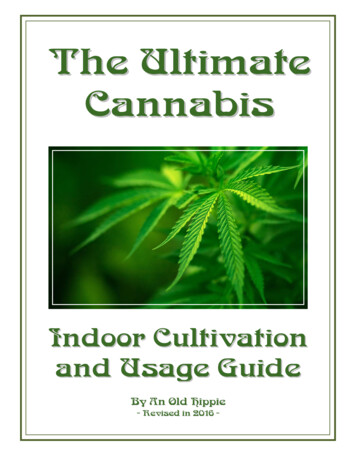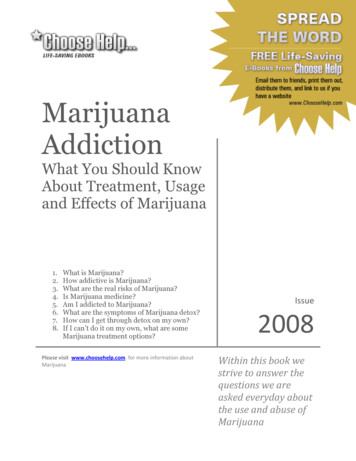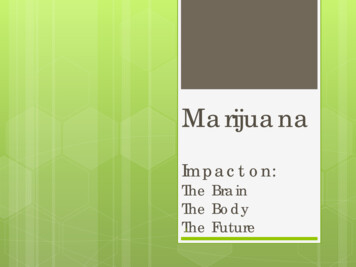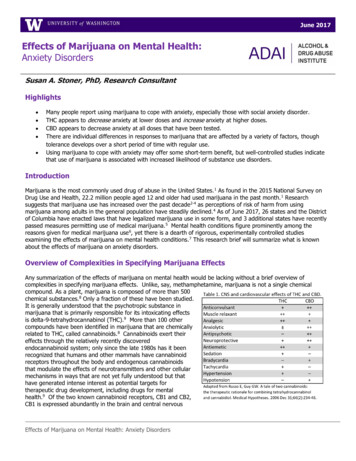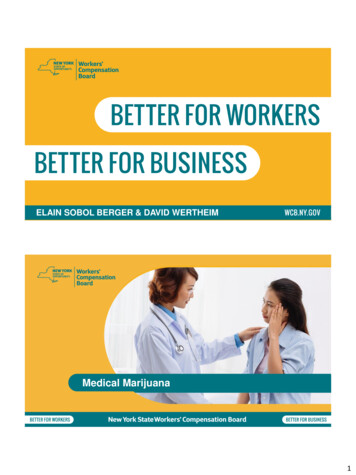
Transcription
ELAIN SOBOL BERGER & DAVID WERTHEIMMedical Marijuana1
NYS Medical Marijuana ProgramBackground: Compassionate Care Act In July 2014, Governor Andrew M. Cuomo and the New York StateLegislature enacted the Compassionate Care Act tocomprehensively regulate the manufacture, sale and use of medicalmarijuana. The program ensures that medical marijuana is available fortreatment of certified patients with serious conditions and isdispensed and administered in a manner that protects public healthand safety12
Federal Law As a Schedule I drug under the Controlled Substances Act of 1970(21 U.S.C. 801), marijuana may not be prescribed, administered, ordispensed, and it is illegal to possess, use, purchase, sell or cultivate. Drug Enforcement Agency (DEA) designates marijuana as aSchedule I controlled substance with: “No currently accepted medical use.” A lack of accepted safety for use under medical supervision, and a highpotential for abuse.2Federal Law The US Attorney General (AG) may by rule transfer a drug or othersubstances between schedules of the Controlled Substance Act(CSA). The AG has delegated this responsibility to the Acting Administrator ofthe DEA. Several drugs containing marijuana products have been approved andtransferred to other Schedules under the CSA. All other marijuana products are Schedule I.33
Federal LawThe Rohrabacher-Blumenauer Amendment (formerly, theRohrabacher-Farr Amendment) Prohibits the DOJ from using federal funds to interfere with statemedical marijuana programs and from prosecuting medicalmarijuana businesses that are compliant with state law. New York is explicitly listed as one of the states with a legalizedmedical marijuana program.4Federal Law“Cole Memo” (former authority) Provided that in jurisdictions with strong and effective regulatorysystems governing legalized marijuana usage, which do notthreaten federal priorities related to medical marijuana. The federal government will rely on state and local officials toenforce laws, and the DOJ will not prosecute cases stemming fromconduct that is permitted under the state’s marijuana legalizationprogram.54
Federal LawMemo issued by former AG Sessions in January 2018(current authority) Rescinded the Cole Memo and three other memos related toexercising prosecutorial discretion around medical marijuana, and Directed federal law enforcement “to use previously establishedprosecutorial principles that provide them all the necessary tools todisrupt criminal organizations, tackle the growing drug crisis, andthwart violent crime across our country.”6New York Law: “Serious Condition”Title V-A in Article 33 of the Public Health Law (PHL) Public Health Law § 3360(7)(a) (i) and (ii) provides the definition of a“serious condition” for which MM may be recommended by a certifiedprovider. 10 NYCRR 1004.2: DOH emergency regulation, currently in effect.75
New York Law: “Serious Condition”Public Health Law § 3360(7)(a): Two ProngsMarijuana may be prescribed pursuant to: PHL §3360(7)(a)(i): for a severe debilitating or life-threateningcondition, and PHL §3360(7)(a)(ii): a condition or symptom that is clinicallyassociated with or is a complication of the severe debilitating orlife-threatening condition.8“Severe Debilitating or Life-ThreateningConditions”Current conditions under PHL 3360(7)(a)(i): Cancer Positive status for human immunodeficiency virus (HIV) or acquiredimmune deficiency syndrome (AIDS) Amyotrophic lateral sclerosis (ALS) Parkinson’s disease96
“Severe Debilitating or Life-ThreateningConditions” (cont’d) Multiple sclerosis Damage to the nervous tissue of the spinal cord with objectiveneurological indication of intractable spasticity Epilepsy Inflammatory bowel disease Neuropathies10“Severe Debilitating or Life-ThreateningConditions” (cont’d) Huntington’s disease Post-Traumatic Stress Disorder (PTSD) Pain that degrades health and functional capability where the useof medical marihuana is an alternative to opioid use, substance usedisorder, or as added by the commissioner **Regulation 1004.2(a)(8)(xiii), expands upon the statutory definition of pain that “degrades healthand functional capability”117
“Pain That Degrades Health andFunctional Capability” (1004.2(a)(8)(xi))Any severe debilitating pain that the practitionerdetermines degrades health and functional capability Where the patient has contraindications, has experienced intolerableside effects, or has experienced failure of one or more previously triedtherapeutic options; and Where there is documented medical evidence of such pain havinglasted three months or more beyond onset, or the practitionerreasonably anticipates such pain to last three months or more beyondonset.12“Pain That Degrades Health andFunctional Capability” (1004.2(a)(8)(xiii))Any severe debilitating pain that the practitionerdetermines degrades health and functional capability(cont’d) Where the use of medical marijuana is an alternative to opioid use, Provided that the precise underlying condition is expressly stated onthe patient’s certification138
Associated ConditionsCurrent associated conditions pursuant to PHL 3360(7)(a)and 10 NYCRR 1004.2: Cachexia or wasting syndrome; Severe or chronic pain resulting in substantial limitation of function; Severe nausea; Seizures;14Associated Conditions (cont’d) Severe or persistent muscle spasms;Post-Traumatic Stress Disorder;Opioid Use Disorder;Or such other conditions, symptoms or complications as added bycommissioner of DOH.159
Routes of AdministrationApproved Routes of Administration Metered liquid or oil preparations Solid and semisolid preparations (e.g., capsules, chewable andeffervescent tablets, lozenges) Metered ground plant preparations Topical forms and transdermal patches16Routes of AdministrationProhibited Routes of Administration The Compassionate Care Act expressly prohibits smoking as a formof MM. (In keeping with New York’s longstanding commitment toeliminate all smoking), as well as edibles.1710
New York State:Workers’ Compensation Law §13 WCL § 13(a) provides that “[t]he employer shall be liable for thepayment of the expenses of medical, dental, surgical, optometric orother attendance or treatment, nurse and hospital service, [and]medicine . for such period as the nature of the injury or the processof recovery may require.”18New York State:Workers’ Compensation Law Beginning with Matter of WDF (2018 NY Wrk Comp G1403803),decided February 16, 2018, the Board has opened the door topermitting treatment with medical marijuana when a variance isrequested (if the Medical Treatment Guidelines apply to the injury orcondition) and requiring carriers to reimburse workers’compensation claimants for such treatment.1911
New York State:Workers’ Compensation Law The Board’s authority in Matter of WDF and its progeny isprincipally based on the Public Health Law and WCL § 13 Matter of Kellner Bros. Inc. (2018 Wrk Comp 80316448) Not the seminal MM case, but the case with the best developedarguments for and against MM20Matter of Kellner Bros. Inc2018 Wrk Comp 80316448Facts: Carrier files an RFA-2OP with the Board seeking opioid weaningconsistent with the Non-Acute Pain Medical Treatment Guidelinesbased on IME report. Claimant was directed to produce up-to-date medical including areport from his physician as to whether alternatives to opioids wereavailable.2112
Matter of Kellner Bros. Inc2018 Wrk Comp 80316448Facts: Treating physician indicated that patient was being weaned off hisopioids and was finding MM “very helpful.” Subsequent IME report indicates that the claimant has “significantlytapered” his opioid use as a result of using a combination of MMand morphine sulfate.22Matter of Kellner Bros. Inc2018 Wrk Comp 80316448Facts: At the August 17, 2017, hearing, the claimant’s counsel indicatesthat the treating physician appears on the DOH registry andrequests that the claimant be reimbursed for the costs of his MMcertification. The carrier objected that MM is illegal under Federal Law and is notan authorized form of treatment because it is not FDA approved.2313
Matter of Kellner Bros. Inc2018 Wrk Comp 80316448Facts: The WCLJ found “ that MM is appropriate medication and medicallynecessary” and accordingly authorized the MM treatment anddirected the carrier to reimburse the claimant for out-of-pocketexpenses regarding MM.24Matter of Kellner Bros. Inc2018 Wrk Comp 80316448Facts: Carrier appeal Federal Pre-emption: Violation of federal CSA. Violation of PHL 3368 (2): “Nothing in (Title 5A of the PHL) shall beconstrued to require an insurer or health plan to provide coveragefor MM.” Conflicts with MTGs because the treating provider did not request avariance to treat with MM.2514
Matter of Kellner Bros. Inc2018 Wrk Comp 80316448Board Panel Decision: The claimant was prescribed medical marijuana to treat chronicpain for an established neck injury. Therefore, the claimant’streating medical provider was required to adhere to the Board’sNon-Acute Pain Medical Treatment Guidelines, which do notauthorize treatment with medical marijuana. The provider shouldhave sought a variance. WCLJ decision rescinded.26MM CompensabilityBoard Panel decisions not only set precedent for permittingtreatment with MM utilizing a variance, but also set forth fourrequirements for determining whether MM is reimbursable.2715
NYS Workers’ CompensationPayments for MMFor a claimant to be reimbursed for MM: The certification must have been written by a medical providerregistered with the DOH to prescribe MM, Who is also Board authorized, For an established site of injury or condition, For a use authorized under Public Health Law (PHL) §3360(7), and In accordance with the Medical Treatment Guidelines (MTGs),where applicable.28NYS Workers’ Compensation: Paymentsfor MMAs marijuana remains a controlled substance under federallaw, carriers cannot implicate the federal banking systemwhen paying for MM.Two options for MM payment: Reimbursement to the claimant, or Permit payment to the dispensary when carrier/SIE does not havefunds in/or associated with the federal banking systemBoard determination: Reimbursement to the claimant2916
NYS Workers’ Compensation: Paymentsfor MM If a variance is approved, payment for MM should be made byreimbursement to the claimant as a medical and travel (M&T)reimbursement. Authority for this stems from WCL §13(a) for “other attendanceand treatment.” PHL §3368(2) exempts health insurers, but workers’ compensationfalls under ‘basic insurance’ not health. Thus, M & T is proper mechanism for the dispensed, varianceapproved, MM.30Payment to ProvidersWCL § 13(a) also provides authority to compelemployers/carriers to pay for all medical visits. A physician should use an appropriate E&M code to reflect theassessment and plan that includes the certification of the patient andprescription for MM. A variance is not to be used for billing for medical visits nor for thecompletion of the patient certificate for MM3117
Variance Request for MMMedical Marijuana is not addressed in the Medical TreatmentGuidelines and a variance is required that supportscompliance with both: The NYS Department of Health’s criteria for the use of MedicalMarijuana, and The Medical Treatment Guideline variance criteria.32Medical Treatment Guidelines And MMOf note, General Guideline Principle A. 20 states: Medical treatment that is experimental/investigational and notapproved for any purpose, application or indication by the FDA isnot permitted under these Guidelines.Question: Since MM is a Schedule I Drug, how can MM beconsidered a treatment option under the MTGs? FDA has approved three drugs containing synthetic marijuanaproducts and one plant derived CBD drug.3318
Federally Approved Marijuana ProductsMarinol: Active ingredient dronabinol, a synthetic THC that mimicsnatural THC. Moved from Schedule I Schedule III in 1999 1985: Nausea and vomiting associated with cancer chemotherapy, notresponsive to conventional anti-emetics 1992: Anorexia with weight loss in AIDSCesamet: Active ingredient nabilone, a synthetic cannabinoid similar toTHC. Schedule II 1985: Nausea and vomiting associated with cancer chemotherapySyndros: Synthetic liquified dronabinol. Schedule II 2016: Same indications as Marinol34Federally Approved Marijuana ProductsEpidiolex: First FDA approved drug derived from plant purifiedcannabidiol (CBD). Schedule V 2018: Difficult-to-control seizures in patients with rare Dravet and LennoxGastaut syndromes3519
Variance Request for MM The variance request must provide documentation that the physician isboth authorized by the WCB to treat injured workers and is registeredby the NYS Department of Health to certify patients for MedicalMarijuana. There must be documentation by the provider that the patient has beencertified for Medical Marijuana and a copy of the certificate for theMedical Marijuana Program must be provided with the variancerequest, and Medical Treatment Guideline criteria are met.36NYS WCB Authorized Providers For a physician to treat WC claimants, the physician must beauthorized by the WCB per WCL § 13-b.3720
Physician/Practitioner Registration CriteriaPursuant to 10 NYCRR §1004.1(a), medical practitionersseeking to issue certifications for their patients to receivemedical marijuana (MM) products must meet the followingcriteria: Be qualified to treat patients with one or more of the seriousconditions set forth in Public Health Law (PHL) §3360(7); Be licensed, in good standing as a physician and practicingmedicine, as defined in Education Law Article 131;38Registration Criteria (cont’d) Have completed a two to four hour course approved by theCommissioner of Health; and Registered with the New York State Department of Health (DOH)Medical Marijuana Program. Once these four requirements have been satisfied, the provider mayrecommend MM to eligible patients.3921
Additional Practitioner Criteria To recommend MM as treatment for Substance Use Disorder(a Serious Condition), or Opioid Use Disorder (an AssociatedCondition),1004.2(a)(10) requires that:“a practitioner must hold a federal Drug Addiction Treatment Act of2000 (DATA 2000) waiver to be qualified to treat patients withsubstance use disorder or opioid use disorder.”40Registration Criteria, NPs and PAsPursuant to 10 NYCRR §1004.1(a)(2), in addition tophysicians, MM may be recommended by: Nurse Practitioners Physician Assistants under the supervision of a physicianregistered by DOH4122
Workers’ Compensation: NPs and PAsNPs and PAs: Currently NPs and PAs can not become WCB authorized andmust be under the direct and personal supervision of a physician As of January 1, 2020 NPs may obtain WCB authorization PAs may obtain WCB authorization with a supervising physician whois WCB authorized.42VarianceIt is recognized there are legitimate reasons forexceptions to the Medical Treatment Guidelines: The variance process defines the criteria for exceptions to theMTGs, including treatment that is not addressed in the guidelines NYS DOH’s qualifying serious and associated conditions includeconditions for which there are MTGs, including Mid and Low Backand Neck and Non-Acute Pain (NAP) However, MM is not addressed as a treatment option in theseGuidelines, so a variance would be required4323
DOH MM Criteria And MTG ConditionsNYS DOH’s MM qualifying serious and associatedconditions that are covered by NYS MTGs include: Damage to the nervous tissue of the spinal cord with objectiveneurological indication of intractable spasticity Neuropathies Severe or persistent muscle spasms44DOH MM Criteria And MTG ConditionsNYS DOH’s MM qualifying serious and associatedconditions that are covered by NYS MTGs (cont’d) Any severe debilitating pain that the practitioner determinesdegrades health and functional capability Severe or chronic pain resulting in substantial limitation of function Alternative to opioid use Opioid Use Disorder4524
Non-Acute Pain MTG and MMThe WC Non-Acute Pain MTG (NAP MTG) provides: A continuum of options for the assessment and management ofpatients with chronic pain Focused on function, alternatives to opioids, tapering anddiscontinuing opioids, as appropriate, with referral to addictionmedicine specialists, as indicated. Virtually all of the MM variance requests received at this time relateto conditions covered in the NAP MTG Meeting the medical necessity criteria for MM requests requiresknowledge of the variance requirements with a focus on clinicaloutcomes (objective functional improvement and management of pain)46MG-2: Medical Necessity RefresherAll variance requests must include:1. A medical opinion stating why the proposed care is appropriate andmedically necessary for the patient,2. Certification by the requesting provider that the patient agrees to theproposed care, and3. An explanation why alternatives under the MTGs are notappropriate or sufficient.4725
MG-2: Medical Necessity RefresherAdditionally, requests to extend treatment beyondrecommended maximum duration/frequency mustinclude: Objective evidence that the requested treatment has producedfunctional improvement, Further improvement is reasonably expected with additionaltreatment. Proposed plan for additional treatment with the treatment durationand frequency, and functional goals.48MG-2: Medical Necessity RefresherFor treatment that is not addressed in NAP MTG, thefollowing must be documented:1. A description of any signs or symptoms which have failed toimprove with previous treatments provided according to MTGrecommendations.2. Proposed treatment plan and an explanation of why proposedtreatment is necessary at this time, including specific functionalgoals.3. Medical evidence in support of proposed treatment (for MM refer toNYS Medical Marijuana Program).4926
Case Example 60 y/o male DOI: 1999 S/P 4 lumbar surgeries Chronic back pain since injury Patient already taking MM Paying out of pocket Variance request for 12 months of MM50Case Example (cont’d) Able to discontinue opioids Last used hydrocodone approximately 6 months ago Documentation supports that MM takes edge off symptoms,decreases back spasms, allows increased daily function andwalking. UDT consistent5127
Case Example (cont’d)Two month trial of MM authorized with re-evaluation(consistent with General Principles) to include: Objective documentation of the efficacy of MM Specific examples of improved/maintenance of function Improved pain management and participation in selfmanagement program No adverse effects Compliance with UDT, I-Stop52Case Example (cont’d)Follow-up: A subsequent MG-2 request for MM wasapproved for 6 months as the criteria for the two month trialwas met.5328
Example: MTG Alternatives Effective According to the provider’s documentation in support of MM, thepatient’s hydrocodone 10/325 TID PRN (max 30mg 30 MED) (EFFECTIVE), Ibuprofen (EFFECTIVE) and voltaren gel (VERY HELPFUL),These medications satisfactorily decrease pain and improve dailyfunction, without side effectsBOP: “An explanation why alternatives under the MTGs are notappropriate or sufficient” has not been met54Examples: MM Related MG-2 Requests Reimbursement of cost of MM and continued use of the same.Patient has been doing well with this under directive of Dr. “X” Documentation by the requesting physician: “Medications from anoutside provider” and there is no further information provided. Reimbursement for E&M 99214 for completion of MM certification* The MG-2 cannot be used to request reimbursement for: Past or current use of MM or E&M billingThe certifying MM provider must be the treating provider submittingthe MG-2*Note: Patients cannot be billed directly for completion of MM certificates5529
NYS DOH Medical Marijuana Programwww.health.ny.gov/regulations/medical marijuana5630
Learning more about the Board@NYSWCB@NYSWorkersCompBoard orkersCompensationBoard#NYSWorkersCompBoard57Thank youQuestions?5831
Workers' Compensation Law The Board's authority in Matter of WDF and its progeny is principally based on the Public Health Law and WCL § 13 Matter of Kellner Bros. Inc. (2018 Wrk Comp 80316448) Not the seminal MM case, but the case with the best developed arguments for and against MM 20 Matter of Kellner Bros. Inc 2018 Wrk Comp 80316448
